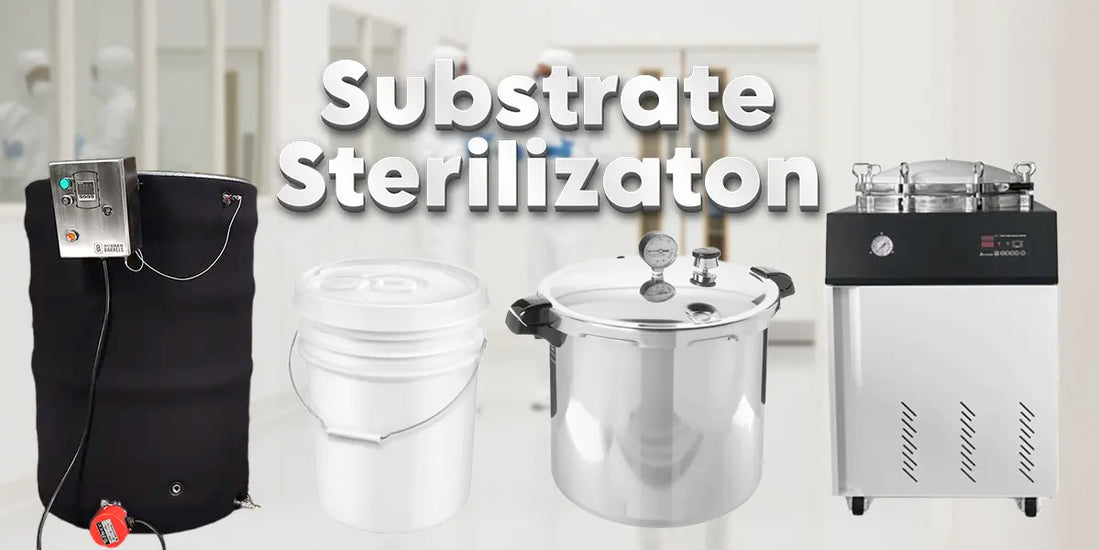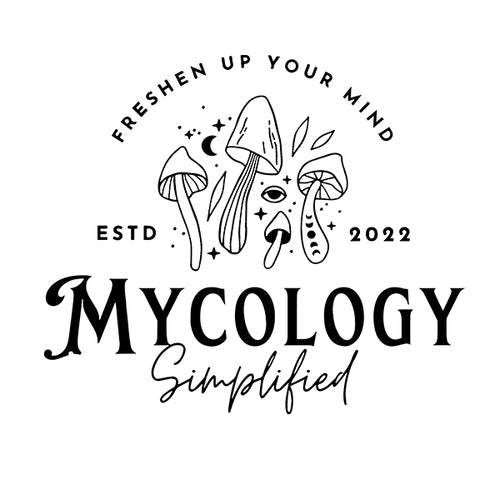
The Role of Sterilization in Efficient Mushroom Cultivation
Compartir
Mushroom cultivation is an intricate process that demands precision and care. One of the key components in ensuring successful mushroom production is sterilization. In this blog post, we’ll dive into the importance of sterilization, exploring why it is essential for creating an optimal growing environment for mushrooms, as well as its impact on yield and quality. Join us as we unpack the science behind sterilization and its role in efficient mushroom cultivation.

Understanding the Basics of Mushroom Cultivation
Mushroom cultivation is a fascinating blend of art and science that starts with understanding the life cycle of fungi. At its core, this process involves creating ideal conditions for the growth of mycelium, the vegetative part of the fungus. To cultivate mushrooms successfully, growers must consider several factors, including temperature, moisture, and airflow. Each species of mushroom has its own unique requirements, which can make this delicate dance quite complex.
An essential element of mushroom cultivation is the substrate, which provides the nutrients needed for mycelium to thrive. Common substrates include straw, wood chips, coffee grounds, and CVG substrate l, each offering different benefits. For instance, straw is rich in nutrients and has an ideal texture for air exchange, while coffee grounds are a fantastic way to recycle waste while providing a nitrogen-rich medium. CVG substrate, which stands for a blend of cocoa coir, vermiculite, and gypsum, has gained popularity for its ability to retain moisture while ensuring proper airflow. This makes it an excellent choice for cultivating various mushroom species. Understanding these substrates is crucial for new growers, as it can significantly impact their success.
Furthermore, mushroom cultivation is heavily influenced by environmental factors such as humidity and light. Mushrooms typically require high humidity levels, which mimic their natural habitat, while light plays a lesser yet still vital role, especially in the fruiting stage. As cultivators navigate these requirements, they must remain vigilant and adaptable to ensure that their mushrooms grow healthy and robust.
What is Sterilization and Why is it Necessary?
Sterilization is the process of eliminating all forms of life, particularly harmful microorganisms that can interfere with mushroom cultivation. This step is crucial because contaminants such as bacteria and molds can rapidly outcompete the desired mushroom species for nutrients, leading to failed crops. Without thorough sterilization, even the most carefully crafted cultivation environment can quickly become a breeding ground for unwanted pests.
The necessity of sterilization in mushroom cultivation is underscored by the fact that even non-pathogenic microorganisms can affect the health of mushroom crops. For instance, certain molds may produce toxins that can be harmful upon consumption. Thus, ensuring a sterile environment not only fosters a successful yield but also safeguards the health of consumers. As such, implementing effective sterilization methods is a fundamental practice that every grower should prioritize.
Beyond microbial control, sterilization also helps maintain a consistent and controlled environment for mushroom growth. This predictability enables cultivators to apply their knowledge and skills more effectively, providing them with the confidence they need to innovate and experiment within their growing processes.

Common Contaminants in Mushroom Cultivation
Understanding common contaminants is vital for anyone venturing into mushroom cultivation. The primary culprits include bacteria, molds, and pests, all of which can derail well-planned growing efforts. Bacteria, especially, can thrive in warm, moist environments, often leading to souring of substrates and failure of the spawn to colonize effectively. These invisible enemies can be a grower’s worst nightmare.
Molds like Trichoderma often invade and can displace the desired fungal species. Their fibers can spread quickly, choking out mushroom mycelium and leading to significant losses in yield. Identifying these molds early is crucial to take corrective actions before they establish themselves. Similarly, pests such as fruit flies and mites can wreak havoc by infecting crops and their substrates, creating a chain reaction of contamination.
To combat these contaminants, growers must be observant and proactive. Regular inspections of the growing area, along with maintaining cleanliness, can go a long way in preventing infestations. By recognizing the signs of contamination early, growers can mitigate the risks of losing their hard work and investment in mushroom cultivation.
Different Methods of Sterilization
There are various methods of sterilization, each with its own advantages and disadvantages. The two most popular methods include autoclaving and steam sterilization. Autoclaving operates by using high-pressure steam to create an environment that kills microorganisms effectively. This method is favored in commercial mushroom cultivation due to its reliability and efficiency. It can sterilize substrates like grains and agar much faster than traditional methods.
Another effective method to consider is pasteurization. Unlike sterilization, which aims to eliminate all microorganisms, pasteurization reduces the overall microbial load. This method involves heating the substrate to a specific temperature for a set period, which kills off competing organisms while keeping the beneficial ones alive. Pasteurization is particularly popular among growers who want to maintain some of the beneficial microbes that can support mushroom growth. It’s a safer and more forgiving process that’s perfect for smaller-scale producers or those looking to use more natural methods. Overall, each technique offers unique benefits, so it’s good to weigh your options based on your specific mushroom cultivation goals.
On the other hand, steam sterilization involves heating the substrate in a water-filled pot or pressure cooker. A great option for amateur growers is the Presto 23qt pressure cooker, which you can easily find on Amazon or at Walmart. This handy little appliance can help you achieve the effective sterilization you need without breaking the bank. It’s spacious enough to hold plenty of substrate, making it a practical choice as you start your mushroom cultivation journey. Just remember, it requires careful monitoring to ensure that the correct temperature and time are maintained. If not executed correctly, the results can be inconsistent, leading to the risk of contamination. This method, however, is beneficial for those starting their journey in mushroom cultivation, offering a simpler approach to achieving sterilization.
Another interesting method is chemical sterilization, which employs solutions like hydrogen peroxide or bleach to kill unwanted organisms. Although it is less common, it can be an effective approach, particularly for tools and surfaces. Using chemical agents requires caution as improper use can result in toxic residues that may harm mushroom growth.
Additionally, cold water sterilization using lime is an innovative technique gaining popularity among mushroom cultivators. This method involves soaking substrates in a lime solution, which raises the pH level and creates an inhospitable environment for many harmful microorganisms. It’s particularly advantageous for those looking for a more natural and less chemical-intensive sterilization approach. Just remember to rinse the substrate thoroughly after soaking to ensure the lime doesn’t negatively affect your mushroom growth.
Each method has its nuances, but the ultimate goal remains the same: creating a clean slate for optimal mushroom cultivation.
Comparing Sterilization Techniques: Pros and Cons
When it comes to choosing a sterilization technique, understanding the pros and cons of each method can help growers make informed decisions. Autoclaving stands out as the gold standard for its efficiency and effectiveness. However, it comes with high costs and requires specialized equipment, making it less feasible for hobbyists. Amateur growers may find steam sterilization more appealing due to its simplicity and lower investment, but it demands careful management to avoid under or over-processing.
Another method that often comes into play is pasteurization. While it doesn’t achieve the complete sterilization that autoclaving does, pasteurization is a fantastic option for those looking to reduce the microbial load on their substrates without completely obliterating all microorganisms. This technique involves heating the substrate to a specific temperature for a set period, effectively targeting harmful pathogens while preserving beneficial microbes that support mushroom growth. It’s a great balance for growers who want to maintain some of the natural flora that can aid in the cultivation process.
For many, pasteurization is seen as a gentler approach that aligns well with natural methods. It’s particularly attractive to smaller-scale producers or those who care about minimizing chemical use. Plus, it can also save time and reduce equipment costs—something that can be really helpful for hobbyists or those just starting out. Just like with any method, the key to success with pasteurization is monitoring those conditions closely to ensure that everything works as it should.
In summary, each method—whether it’s autoclaving, steam sterilization, or pasteurization—has its strengths, and the best choice really depends on your particular situation and goals in mushroom cultivation.
Best Practices for Effective Sterilization
Effective sterilization requires adopting best practices that ensure a thorough and successful process. First and foremost, cleanliness is paramount. Before any sterilization procedure, it is crucial to clean the working space, tools, and ingredients thoroughly. A spotless environment minimizes contamination risks, creating a safer atmosphere for mushroom cultivation. This includes using disinfectants on surfaces and maintaining tidy storage areas.
Furthermore, monitoring sterilization conditions is essential. Whether using an autoclave or a pressure cooker, it is vital to keep track of temperature and time throughout the process. Many growers utilize monitoring devices like temperature probes to ensure that the substrate reaches the recommended temperature for an adequate duration. Attention to detail in this stage can determine the success or failure of the subsequent inoculation.
The Impact of Sterilization on Mushroom Yield and Quality
The impact of sterilization on mushroom yield and quality cannot be overstated. A properly sterilized environment cultivates healthy mycelium that grows more vigorously and fruits more abundantly. On the contrary, if even a small amount of contamination slips through, the results can be detrimental. Contaminated substrates lead to weak, unhealthy mushrooms that may not develop properly, showing stunted growth and reduced size.
Additionally, the quality of the harvested mushrooms is significantly influenced by the sterilization methods employed. Sterile conditions not only enhance the appearance of the fruit bodies but also improve their flavor and nutritional content. Ultimately, consumers are more likely to choose mushrooms that exhibit vibrant colors and maintain quality standards, further supporting the worth of investing time and resources into proper sterilization practices.
Therefore, growers must recognize the profound link between sterilization and overall success in mushroom cultivation. By prioritizing an efficient sterilization protocol, they lay the groundwork for a thriving production environment that yields high-quality, flavorful mushrooms. This connection fortifies the importance of becoming knowledgeable and skilled in effective sterilization methods, acting as a cornerstone of success for any mushroom grower.
Wrapping Up the Importance of Sterilization
In conclusion, sterilization is a critical step in mushroom cultivation that cannot be overlooked. By ensuring the growing environment is free from contaminants, growers can significantly enhance the quality and quantity of their yields. Understanding the various sterilization methods allows cultivators to choose the best practices tailored to their specific needs, ultimately leading to a more fruitful harvest. Whether you are a seasoned grower or just starting, effective sterilization can lead to successful mushroom cultivation.
LInks:
